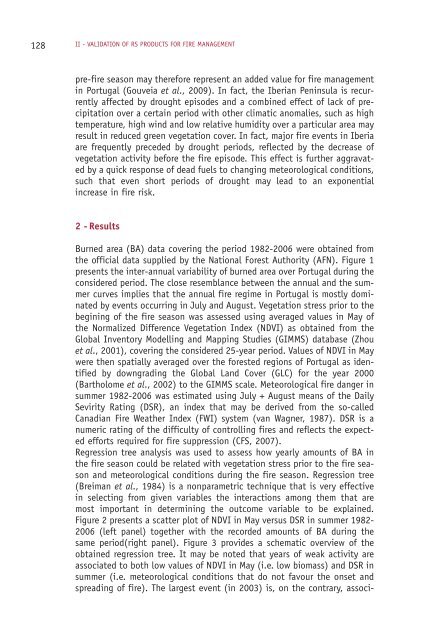7th Workshop on Forest Fire Management - EARSeL, European ...
7th Workshop on Forest Fire Management - EARSeL, European ...
7th Workshop on Forest Fire Management - EARSeL, European ...
You also want an ePaper? Increase the reach of your titles
YUMPU automatically turns print PDFs into web optimized ePapers that Google loves.
128<br />
II - VALIDATION OF RS PRODUCTS FOR FIRE MANAGEMENT<br />
pre-fire seas<strong>on</strong> may therefore represent an added value for fire management<br />
in Portugal (Gouveia et al., 2009). In fact, the Iberian Peninsula is recurrently<br />
affected by drought episodes and a combined effect of lack of precipitati<strong>on</strong><br />
over a certain period with other climatic anomalies, such as high<br />
temperature, high wind and low relative humidity over a particular area may<br />
result in reduced green vegetati<strong>on</strong> cover. In fact, major fire events in Iberia<br />
are frequently preceded by drought periods, reflected by the decrease of<br />
vegetati<strong>on</strong> activity before the fire episode. This effect is further aggravated<br />
by a quick resp<strong>on</strong>se of dead fuels to changing meteorological c<strong>on</strong>diti<strong>on</strong>s,<br />
such that even short periods of drought may lead to an exp<strong>on</strong>ential<br />
increase in fire risk.<br />
2 - Results<br />
Burned area (BA) data covering the period 1982-2006 were obtained from<br />
the official data supplied by the Nati<strong>on</strong>al <strong>Forest</strong> Authority (AFN). Figure 1<br />
presents the inter-annual variability of burned area over Portugal during the<br />
c<strong>on</strong>sidered period. The close resemblance between the annual and the summer<br />
curves implies that the annual fire regime in Portugal is mostly dominated<br />
by events occurring in July and August. Vegetati<strong>on</strong> stress prior to the<br />
begining of the fire seas<strong>on</strong> was assessed using averaged values in May of<br />
the Normalized Difference Vegetati<strong>on</strong> Index (NDVI) as obtained from the<br />
Global Inventory Modelling and Mapping Studies (GIMMS) database (Zhou<br />
et al., 2001), covering the c<strong>on</strong>sidered 25-year period. Values of NDVI in May<br />
were then spatially averaged over the forested regi<strong>on</strong>s of Portugal as identified<br />
by downgrading the Global Land Cover (GLC) for the year 2000<br />
(Bartholome et al., 2002) to the GIMMS scale. Meteorological fire danger in<br />
summer 1982-2006 was estimated using July + August means of the Daily<br />
Sevirity Rating (DSR), an index that may be derived from the so-called<br />
Canadian <strong>Fire</strong> Weather Index (FWI) system (van Wagner, 1987). DSR is a<br />
numeric rating of the difficulty of c<strong>on</strong>trolling fires and reflects the expected<br />
efforts required for fire suppressi<strong>on</strong> (CFS, 2007).<br />
Regressi<strong>on</strong> tree analysis was used to assess how yearly amounts of BA in<br />
the fire seas<strong>on</strong> could be related with vegetati<strong>on</strong> stress prior to the fire seas<strong>on</strong><br />
and meteorological c<strong>on</strong>diti<strong>on</strong>s during the fire seas<strong>on</strong>. Regressi<strong>on</strong> tree<br />
(Breiman et al., 1984) is a n<strong>on</strong>parametric technique that is very effective<br />
in selecting from given variables the interacti<strong>on</strong>s am<strong>on</strong>g them that are<br />
most important in determining the outcome variable to be explained.<br />
Figure 2 presents a scatter plot of NDVI in May versus DSR in summer 1982-<br />
2006 (left panel) together with the recorded amounts of BA during the<br />
same period(right panel). Figure 3 provides a schematic overview of the<br />
obtained regressi<strong>on</strong> tree. It may be noted that years of weak activity are<br />
associated to both low values of NDVI in May (i.e. low biomass) and DSR in<br />
summer (i.e. meteorological c<strong>on</strong>diti<strong>on</strong>s that do not favour the <strong>on</strong>set and<br />
spreading of fire). The largest event (in 2003) is, <strong>on</strong> the c<strong>on</strong>trary, associ-
















